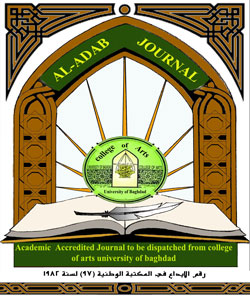Man and the homeland in the products of GeRshon Shofman
DOI:
https://doi.org/10.31973/aj.v1i130.638Keywords:
גרשון שופמן, יצירות ספרותיות, האדם, הארץAbstract
The Jewish writer Gershon Shofman, born in Russia in 1880 and he died in Palestine in 1972, has ridiculed most of his literary productions, especially his stories, to show the role of man in his society and the suffering of the conflict and the difficulties of life.
Shofman also shed light on the role of man in the building of the nation. In this context, Schofman used the meaning of the homeland, the homeland of the intended Jews, where he sometimes spoke directly and indirectly indirectly. The aim of all this is to encourage Jews, especially Eastern European Jews, to immigrate to their homeland.
In most of his stories, Shofman focused on the events that took place in the Jews since the 1905 events in Russia and the failed revolution there, as well as the events of the First and Second World Wars, the war between Jews and Arabs and the establishment of the State of Israel.
Shofman also discussed the subject of the escape of man from his homeland, especially the Jewish man and his transfer from one country to another in vain. The result was his migration to the Promised land.
Downloads
References
Ben-Garion, Emanuel. Schoffman within us. Luria (Tel Aviv 1950).
Feingold, Ben-Ami. Gershon Schoffman: Revenge of the Singing Box. Ramot (Tel Aviv 1989).
Fichman, Jacob. Schoffman in his revelation. Dvir (Tel Aviv 1950).
Gil, Moshe. Selected reporters. Reuven Mess (Jerusalem 1970).
Gil, Moshe. The Jew and the Man in the writings of G. Schoffman. Am Oved (Tel Aviv 1954).
Guvrin, Nurit. From Horizon to Horizon: G. Schoffman, his life and work. Tel Aviv University (Tel Aviv 1982).
Iron, Hillel. Schoffman's first story. Jezreel (Tel Aviv 1970).
Iron, Hillel. Vision and vision: Gershon Schoffman. Together (Tel Aviv 1987).
Kramer, hello. The art of Gershon Schoffman's story. Am Oved (Tel Aviv 1961).
Kritz, Reuven. On the roles of poetics in Schoffman's stories. Bialik Institute (Jerusalem 1969).
Negev, Eilat, intimate conversations: Gershon Schoffman. Bialik Institute (Jerusalem 1995).
Negev, Eilat. He loved youth: about Schoffman's works. Tel Aviv University 1995.
Ovadia, Mordechai. '' Chapters C. Schoffman: Tags for his character and work. Dvir (Tel Aviv 1960).
Recommend, David. What is Gershon Schoffman for us. Tel Aviv University (Tel Aviv 1994).
Reznik, Shlomo. In the company of G. Schoffman. Bialik Institute (Jerusalem 1970).
Sadan, Dov. Between law and account. Dvir (Tel Aviv 1963).
Schoffman, Gershon. Written by G. Schoffman. Vol. 1- 3- 4. a. . Stable (New York 1927-1935).
Shaked, Gershon. Forms and worldview in Schoffman's work. Am Oved (Tel Aviv 1953).
Shaked, Gershon. No way out: on y. H. Brenner, G. Schoffman. Kibbutz Hameuchad (Tel Aviv 1973).
Downloads
Published
Issue
Section
License
Copyright and Licensing:
For all articles published in Al-Adab journal, copyright is retained by the authors. Articles are licensed under an open access Creative Commons CC BY 4.0 license, meaning that anyone may download and read the paper for free. In addition, the article may be reused and quoted provided that the original published version is cited. These conditions allow for maximum use and exposure of the work.
Reproducing Published Material from other Publishers: It is absolutely essential that authors obtain permission to reproduce any published material (figures, schemes, tables or any extract of a text) which does not fall into the public domain, or for which they do not hold the copyright. Permission should be requested by the authors from the copyrightholder (usually the Publisher, please refer to the imprint of the individual publications to identify the copyrightholder).
Permission is required for: Your own works published by other Publishers and for which you did not retain copyright.
Substantial extracts from anyones' works or a series of works.
Use of Tables, Graphs, Charts, Schemes and Artworks if they are unaltered or slightly modified.
Photographs for which you do not hold copyright.
Permission is not required for: Reconstruction of your own table with data already published elsewhere. Please notice that in this case you must cite the source of the data in the form of either "Data from..." or "Adapted from...".
Reasonably short quotes are considered fair use and therefore do not require permission.
Graphs, Charts, Schemes and Artworks that are completely redrawn by the authors and significantly changed beyond recognition do not require permission.
Obtaining Permission
In order to avoid unnecessary delays in the publication process, you should start obtaining permissions as early as possible. If in any doubt about the copyright, apply for permission. Al-Adab Journal cannot publish material from other publications without permission.
The copyright holder may give you instructions on the form of acknowledgement to be followed; otherwise follow the style: "Reproduced with permission from [author], [book/journal title]; published by [publisher], [year].' at the end of the caption of the Table, Figure or Scheme.












